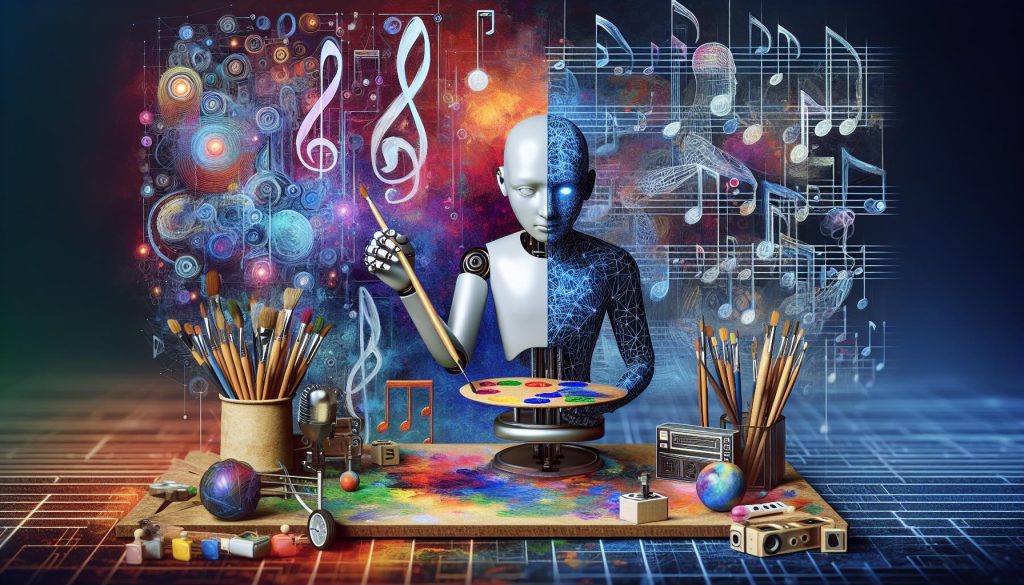Imagine a world where artificial intelligence (AI) isn’t just a tool but a collaborator in the creative process. We’re already seeing Techprimex.co.uk glimpses of this transformation, from AI-generated paintings to music compositions that stir emotions just like human-made pieces. The role of AI in creative industries is evolving rapidly, shaping the future of art, design, music, film, and more.
But how exactly will this technology influence creativity? Will it enhance human potential or overshadow authentic artistic expression? Let’s dive deep into this fascinating journey.
The Current Landscape of AI in Creative Industries
AI is not a futuristic concept anymore; it’s here, actively influencing various creative domains. From automating repetitive tasks to generating innovative content, AI-powered tools are revolutionizing workflows.
AI in Visual Arts
AI algorithms can now create stunning digital artwork. Tools like DALL·E and MidJourney allow artists to generate complex visuals based on simple text prompts. This not only saves time but also opens doors to imaginative possibilities that were previously unattainable.
AI in Music Composition
Musicians are using AI to compose symphonies, generate beats, and even analyze trends in popular music. Platforms like AIVA and Amper Music assist artists in crafting unique sounds, blending human creativity with algorithmic precision.
AI in Writing and Content Creation
Content creators rely on AI-driven platforms to draft articles, suggest headlines, and even optimize content for search engine optimization (SEO). This doesn’t replace writers but enhances their ability to produce engaging, high-quality content faster.
How AI Enhances Creative Processes
Automating Repetitive Tasks
Let’s face it—creative work isn’t always glamorous. Tasks like photo retouching, video editing, and formatting can be tedious. AI automates these processes, allowing artists to focus on the core of their creativity.
Generating Fresh Ideas
When creative blocks hit, AI can be a lifesaver. By analyzing vast datasets, AI tools suggest unique concepts, storylines, and designs that inspire artists to think outside the box.
Personalizing User Experiences
In marketing and advertising, AI helps create personalized content that resonates with specific audiences. This level of customization wasn’t feasible without advanced algorithms analyzing consumer behavior.
The Challenges of Integrating AI in Creative Fields
While AI offers numerous advantages, it’s not without challenges.
The Fear of Replacing Human Creativity
Many artists worry that AI might replace their roles. However, it’s essential to view AI as a collaborator rather than a competitor. Human emotions, experiences, and intuition are irreplaceable elements of genuine art.
Ethical Concerns
Who owns AI-generated art? This question raises complex ethical and legal issues. Copyright laws are still catching up with technology, creating gray areas around authorship and intellectual property rights.
Quality Control
AI can generate content quickly, but it lacks the nuanced judgment of a human creator. This often requires additional oversight to ensure the final product meets quality standards.
Step-by-Step Guide: Leveraging AI in Your Creative Work
Ready to embrace AI in your creative journey? Here’s a simple guide:
Identify Your Needs
Determine which parts of your creative process could benefit from automation or AI assistance. Is it idea generation, design, content creation, or marketing?
Choose the Right Tools
Research AI platforms tailored to your industry. For writers, tools like Jasper or Grammarly are invaluable. Designers might explore Canva’s AI features, while musicians can experiment with platforms like AIVA.
Experiment and Adapt
Don’t expect perfection right away. Experiment with different tools, learn their strengths and limitations, and adapt your workflow accordingly.
Maintain Creative Control
Use AI as a supportive tool, not a replacement. Always add your personal touch to ensure the authenticity and uniqueness of your work.
The Future of AI in Creative Industries
The future looks promising and dynamic. As AI technology advances, we can expect:
Hyper-Personalized Content
AI will enable brands to create content tailored to individual preferences on an unprecedented scale, enhancing customer engagement and loyalty.
Enhanced Collaboration Tools
Imagine virtual workspaces where AI assists in real-time, offering suggestions, automating edits, and predicting creative trends. This will redefine collaboration in remote and hybrid environments.
New Artistic Mediums
We’ll see the emergence of entirely new art forms, blending traditional techniques with digital innovations powered by AI.
Real-Life Stories: AI and Human Creativity in Harmony
Consider the story of Edmond de Belamy, an AI-generated portrait that sold for $432,500 at Christie’s auction. Created by Paris-based art collective Obvious, this piece sparked global debates about the definition of art in the age of AI.
Another inspiring example is how musicians like Taryn Southern are using AI to compose songs, blending her unique style with AI-generated melodies to produce tracks that resonate deeply with audiences.
Final Thoughts
The role of AI in creative industries is not to replace but to empower. It enhances human potential, streamlines workflows, and inspires new artistic horizons. By embracing AI as a partner in creativity, we can unlock possibilities beyond our imagination.
So, whether you’re an artist, writer, musician, or marketer, it’s time to explore how AI can elevate your creative journey. The future is not just human or AI—it’s a collaboration of both, shaping the next chapter in the story of creativity.

